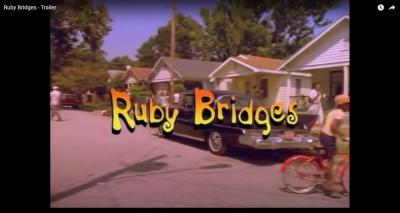Ruby Bridges (1998)

Screenshot from the "Ruby Bridges" movie trailer
Visual Parables content ratings:
- Violence: 3/10
- Language: 2/10
- Sex & Nudity: 1/10
- Star Rating: 5 stars
“Ruby Bridges” tells the story of how a six-year old Black girl integrated a New Orleans segregated school in 1960.
Of course, Ruby didn’t achieve this feat alone – there was the NAACP that chose her; four US Marshalls that kept back the angry mob of haters bent on lynching her; a kind-hearted white teacher who pushed back against her racist superiors; a famous psychiatrist to help her with the stress; and, most of all, her courageous mother who shared the deep faith that gave the girl the strength to persist.
Not expecting a whole lot of it because it is a Disney film, it turned out to soar way beyond my expectations.
The dramatic story begins with Dr. Broyard (Peter Francis James) of the NAACP, who is so impressed by Ruby’s test scores after kindergarten that he visits the Bridges with the proposal that their bright daughter be one of the students to integrate William Frantz Elementary School. Her father, Abon, (Michael Beach) is not so sure about the proposal, but her mother, Lucielle ‘Lucy’ Bridges (Leia Rochon), readily agrees, as does young Ruby (Chaz Monet).
The next day four Federal Marshals show up to escort mother and daughter to the school. They are definitely needed to face the hate-filled crowd, carrying signs with racial slurs, and chanting, “2-4-6-8, We don’t want to integrate.” This is the most frightful part of the film, the vicious crowd showing up every day that Ruby attends school to spew their venom.
White parents withdraw their children from school, and most of the white teachers refuse to accept a “colored” pupil. Fortunately for Ruby, newcomer Mrs. Henry (Penelope Ann Miller), from Boston, says she has no problem teaching just one student, and she and Ruby get along well.
Ruby also receives help from Dr. Robert Coles (Kevin Pollak), a psychiatrist who has worked with children facing stress. Ruby is not eating and acts bizarrely with her doll. Cole is also puzzled by her persistence in returning each day to face the hatred of the crowd and the shunning of most of the staff and students. By what means is she coping?
The family’s religious life plays an important role. Early on, we see them in a joyful church scene where the pastor preaches a relevant social gospel, declaring, “We are a people under fire.” There are several scenes in which Lucielle talks with her daughter, connecting Jesus with what Ruby is going through by telling her, “Jesus faced a mob too, just like you. You know what he did? He prayed for them.”
Things do begin to change. A Methodist minister brings his son back to the school, even though the crowd yells that he is a traitor. Another child runs up the school steps despite his mother’s call to come back. The hostility of fellow teacher Miss Spencer (Patrika Darbo) slowly melts beneath the warmth of Mrs. Henry. She declares out loud that the latter is a good teacher and agrees that the first graders in her second grade class can sit in part of the time with Ruby. The white children at first reflect the prejudice of their parents, but this is eroded by Ruby’s graceful charm and the encouragement of Mrs. Henry. By the end of the film there is hope – we see the white boy smiling with Ruby as they sit together on the schoolyard merry-go-round – though we know it was just the end of 1960 (or early 1961) and that there was yet a long road filled with grief still ahead for those striving to overcome racial barriers.
A combination of good acting and superb writing and direction make this, in my opinion, one of the best, if not the best, Disney live-action films that I have seen. I cannot recommend it too highly, especially for those continuing in their quest to understand racism in America and to honor those who courageously stood up to it, often at great cost to themselves and their loved ones.
